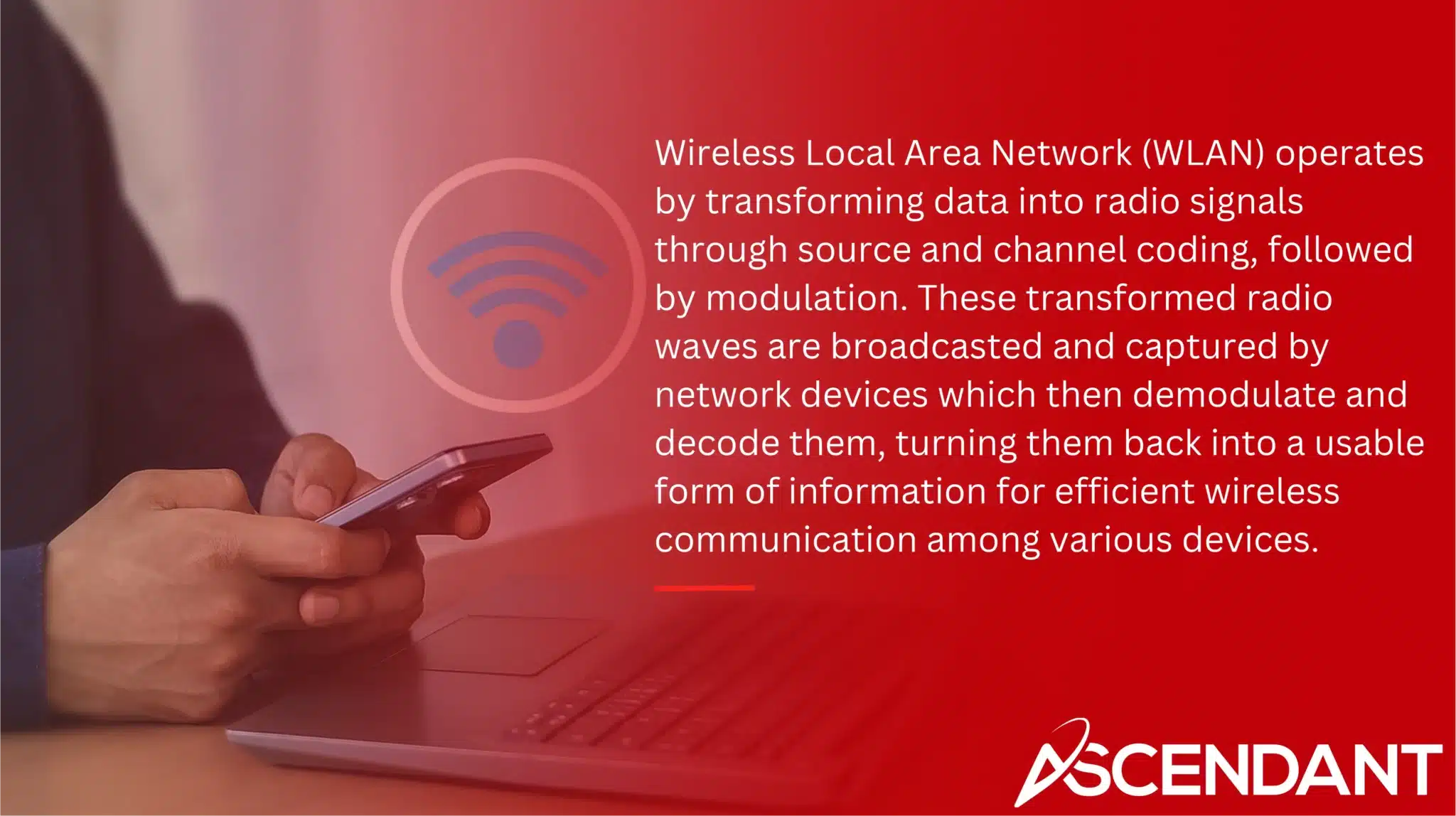A Wireless Local Area Network (WLAN) connects devices within a specific area using wireless communication instead of physical cables. WLAN uses radio waves for data transmission, which provides flexibility and mobility for users. This guide covers the basics of WLAN, its components, types, and how it enhances connectivity in homes, offices, and other environments.
In This Article:
- What is WLAN?
- How WLAN Works
- Security in WLAN
- Advantages and Disadvantages of WLAN
- Advanced WLAN Features
- Cloud-Managed WLAN
- Setting up a WLAN
Key Takeaways
- A WLAN connects devices wirelessly within a limited area using radio waves, enhancing mobility and flexibility compared to traditional wired networks.
- WLANs utilize various wireless technologies, such as Wi-Fi, cellular, and Bluetooth, with Wi-Fi being the most common due to its ease of use and compatibility.
- Security measures, including strong encryption and robust configurations, are essential to mitigate vulnerabilities in WLANs and protect against unauthorized access.
What is WLAN?
A wireless local area network (WLAN) facilitates the connection of devices within a confined space through the use of wireless communication methods. This is in contrast to traditional wired networks that depend on physical connections via network cables. Through radio waves, WLANs enable connected devices to maintain internet access and connectivity without being tied to wires, offering users the ability to roam freely within the coverage area while remaining online.
The chief role of a WLAN lies in its capacity to allow for seamless interaction between assorted devices over radio signals instead of relying on cabled connections. The elimination of these tangible connectors renders WLANs particularly suitable for settings where dynamic and adaptable networking options are favored—such as residential environments, educational institutions, business campuses, and offices—providing enhanced flexibility along with ease-of-movement throughout the designated local area network wlan zone.
By introducing ways to connect wirelessly with our various digital tools, wi fi technologies have redefined how we utilize internet services across different spaces free from restrictions imposed by physical wiring requirements. Be it for setting up personal Wi-Fi networks at home or orchestrating an enterprise-level system architecture. Grasping both WLAN fundamentals and broader principles underlying wireless technology is crucial for ensuring top-notch efficiency when deploying such modern-day networking solutions.
Types of WLANs
Before:
Wireless Local Area Networks (WLANs) can be built using a variety of wireless technologies. These include widely recognized options such as Wi-Fi, cellular technology, and Bluetooth. Each option brings its unique set of benefits that make it more suitable for certain uses than others. For example, the simplicity and reliability of Wi-Fi have made it the go-to choice for domestic and office setups. On-the-move communications often rely on cellular networks. While Bluetooth is frequently selected for connecting devices over shorter distances.
After:
Wireless Local Area Networks (WLANs) are created leveraging diverse forms of wireless technologies, which comprise:
- Wi-Fi, noted for its straightforward setup and dependable performance – making it a preferred selection in residential spaces and workplace environments.
- Cellular technology stands out as crucial to communication on-the-go.
- Bluetooth proves optimal when aiming to establish short-distance connections between devices within wireless communications realms.
Each type comes with specific strengths tailored to various user needs.
The access point (AP), an essential piece in any WLAN configuration, emits signals enabling device linkage and interaction across the network. Strategic placement of these access points helps ensure expansive reachability along with peak functionality throughout the space served by them. Devices tied to this web—collectively referred to as stations—encompass gadgets like computers, mobile phones tablets among others equipped with features compatible with a wireless distribution system capability at hand.
Commencing a WLAN necessitates picking an appropriate wireless router contingent upon desired coverage scope accompanied by meticulous strategy towards hardware location decisions coupled closely with deliberations surrounding frequency selections plus management protocols regarding user admissions—all playing pivotal roles in crafting durable yet effective WLAN infrastructure arrangements.
WLAN vs. Wi-Fi
WLAN, or wireless local area network, is an umbrella term for networks that enable wireless connectivity in a localized setting. In contrast, Wi-Fi refers to the specific subset of WLANs adhering to IEEE 802.11 standards and is recognized by its trademark designation. Essentially, while all Wi-Fi networks fall under the category of WLANs due to their reliance on wireless technology for communication within a defined area, not every WLAN employs Wi-Fi protocols.
There are several technologies available for creating WLANs aside from Wi-Fi. Wi-Fi’s dominance stems from its user-friendly setup process along with cost-efficiency and broad device compatibility attributed to compliance with IEEE 802.11 standards. These set guidelines ensure seamless integration and consistent functionality among various devices and brands when connecting via these ubiquitous wi-fi networks.
Grasping the nuances between general WLAN systems and specialized Wi-Fi can provide clarity regarding why wifi has become such an integral aspect of daily technological interaction. Notably though every wifi connection represents a form of Wireless Local Area Network (WLAN), it doesn’t hold true in reverse—not all instances of WLANS utilize wifi technology, which points towards considering individual requirements when choosing appropriate solutions for wire-free communications.
How WLAN Works

Wireless Local Area Network (WLAN) operates by transforming data into radio signals through source and channel coding, followed by modulation. These transformed radio waves are broadcasted and captured by network devices which then demodulate and decode them, turning them back into a usable form of information for efficient wireless communication among various devices.
A plethora of devices can engage in WLAN connectivity including desktop computers, laptops, smartphones, tablets, IoT endpoints, as well as other gadgets equipped with wireless capabilities. To maintain robustness and reliability in data transfer within the network architecture of a WLAN lies a complex array of interfaces and channels connecting both transmitting and receiving ends.
Understanding the intricacies behind how WLAN functions is key to boosting network performance while ensuring seamless interaction between all connected components on the network. Every element plays an integral role, from how data traverses through airwaves to compatibility among different types of hardware ensures that every aspect is crucial for sustaining WLAN operations.
Components of a WLAN
Wireless Access Points (WAPs) play a critical role in the function of Wireless Local Area Networks (WLANs). They serve as bridges at Layer 2, allowing for integration between the wireless standard 802.11 and the wired standard 802.3. WAPs broadcast radio waves to permit devices with wireless capabilities to establish connections and engage in communication across the network.
Within a WLAN, all participating components including access points and endpoint stations are designated by unique network addresses. These specific identifiers are essential for orchestrating network traffic flow and guarantee that information is correctly relayed to its intended device destination.
Understanding the elements that constitute a WLAN is beneficial when it comes to designing an effective wireless network structure or sustaining its security measures efficiently.
WLAN Networking Modes
Wireless Local Area Networks (WLANs) function using two main modes of networking: infrastructure and ad hoc. Within the infrastructure mode, devices are linked through a central base station, known as an access point. This setup is prevalent in residential and office settings where there’s a need for a consistent and controlled network.
On the other hand, ad hoc mode facilitates direct connections between devices without necessitating a central base station, promoting simple peer-to-peer exchanges. This configuration works best for creating spontaneous networks or in scenarios where setting up centralized network resources isn’t practical.
Roaming capabilities within WLANs can be divided into Layer 2 roaming and Layer 3 roaming. This distinction hinges on whether users move across different subnets while they roam. Understanding these distinct WLAN operational modes aids in selecting an appropriate networking arrangement that aligns with specific requirements and contexts.
Security in WLAN
Wireless Local Area Networks (WLANs) provide exceptional convenience and adaptability, yet they are not without security risks. Without adequate protection, WLANs can be susceptible to a variety of threats that could compromise the network’s integrity. It is imperative to bolster security measures in order to preserve the privacy of data exchanges and prevent unauthorized access.
A significant concern regarding WLAN security is the potential for data interception or alteration as it travels through the airwaves. To counteract these vulnerabilities, implementing stringent security protocols and procedures is vital. Strengthening your wireless network’s defense with advanced encryption methods, firewall applications, and two-factor authentication dramatically increases its resilience against breaches.
Understanding and addressing the various aspects of WLAN security will help maintain both the integrity and confidentiality within your wireless network framework. By adopting recommended practices for safety management while keeping abreast of emerging threats, you can foster an environment where your wireless local area network operates securely and dependably.
Common Threats to WLAN
WLANs face the considerable threat of unauthorized entry, often due to inadequate passwords or missing encryption measures. Hackers can establish rogue access points which pose a risk by penetrating networks and breaching security protocols. Capturing sensitive data during transfer is a common concern as this information may be intercepted.
Compared to wired networks, WLANs typically have more exposure to security risks. Acknowledging these prevalent dangers is essential in safeguarding your WLAN against possible incursions and ensuring the protection of your information.
Enhancing WLAN Security
Implementing robust encryption standards, like WPA2 or WPA3, is essential to secure a WLAN. By setting up these protocols on network devices, you protect your network from unwelcome intrusions and guarantee the protection of data integrity, thus preserving the privacy and security of your network.
Strengthening the security measures for your WLAN aids in defending against possible risks while securing data exchanges across your network. Embracing recommended procedures and keeping abreast with contemporary security protocols are pivotal steps toward establishing a fortified and safe WLAN infrastructure.
Advantages and Disadvantages of WLAN
Wireless Local Area Networks (WLANs) provide a range of benefits that contribute to their widespread adoption in both home and business settings. As the number of devices capable of connecting to the internet rises, WLANs become increasingly favored due to their elimination of the need for physical wiring. Companies experience enhanced communication capacities with wireless local area networks while avoiding the costs associated with cable installation.
Nevertheless, there are downsides to utilizing WLAN technology as well. These include potential security risks and disruptions caused by signal interference. It’s essential for users to be aware of these advantages and disadvantages when considering whether or not to integrate wireless LAN into their networking strategies.
Benefits of WLAN

WLANs offer substantial adaptability, enabling the straightforward integration or disconnection of workstations in response to changing operational demands. This flexibility to adjust WLAN resources with minimal hardware expenditure enhances their capacity to evolve alongside business requirements. WLANs improve collaborative efforts by empowering users to link various devices wirelessly, liberating them from the limitations imposed by physical connections.
Cloud-managed WLANs simplify the management and lessen the complexity within network administration, facilitating business growth without necessitating extensive investments in hardware. The adoption of these advanced technologies may result in notable reductions in both setup and maintenance costs when juxtaposed against conventional wired networks.
Drawbacks of WLAN
WLANs, while beneficial, frequently fall victim to password attacks, necessitating the importance of generating robust passwords. Performance can also be negatively impacted by signal interference caused by environmental conditions like rain. Physical obstacles along with various environmental elements have a considerable influence on signal strength and quality, which presents difficulties in sustaining a dependable network connection.
Recognizing these limitations is valuable for strategizing and executing WLAN solutions that address potential problems and improve overall functionality.
Advanced WLAN Features
Advanced WLAN features focus on improving both the performance and usability of wireless networks. These features enhance network performance and user experience by optimizing connectivity and management.
WLANs can be set up quickly and are less cumbersome compared to wired networks, offering flexibility and lower installation costs.
WLAN Roaming
WLAN roaming facilitates uninterrupted movement for users between access points, enabling them to maintain a continuous connection. This seamless transition enhances the user experience by preventing disruptions in network connectivity as they move from one access point to another.
To improve this process, fast roaming technologies have been developed which minimize the time it takes for a device to transfer its connection between access points. This ensures that users experience a stable and uninterrupted network access even when on the move.
Mesh Networks
Mesh networks enhance WLAN coverage through a system of interlinked nodes that interact with one another. This network configuration offers a robust and reliable connection over an expansive area, while also being capable of dynamically adjusting to alterations in network conditions.
The direct communication between devices within mesh networks bolsters the performance and sturdiness of the overall network structure.
Cloud-Managed WLAN
A WLAN managed via the cloud facilitates distant deployment and supervision, providing centralized control while reducing costs and offering budgetary adaptability. Such solutions liberate IT resources to focus on more value-adding activities by making the management of networks more efficient.
Simplified Management
WLAN solutions that are managed via the cloud consolidate network management, offering a unified interface for both setup and problem-solving. This strategy streamlines the administration of networks and diminishes the necessity for on-location upkeep, thus facilitating remote supervision of different network components.
Scalability and Flexibility
Cloud solutions offer centralized management, which simplifies the task of managing evolving networking demands, enabling businesses to easily scale and adapt their networks as growth and changes in network usage occur. This system minimizes the need for substantial hardware investments when expanding networks.
Setting Up a WLAN
Establishing a Wireless Local Area Network (WLAN) necessitates a thorough examination of requirements, choosing suitable devices, and following an organized method for setting it up. This entails determining the extent of network coverage required, assessing capacity demands, and identifying the particular devices that will be connected to the network.
Planning Your WLAN
A successful WLAN design begins with understanding network coverage, capacity needs, and the specific devices that will connect. Effective WLAN coverage planning involves ensuring enough signal strength and overlap for seamless device connectivity.
Considering the physical layout and potential obstacles that may impact wireless coverage is essential during planning.
Configuring Network Devices
Optimally configuring network devices entails selecting the appropriate channel widths, frequencies, and strategically positioning access points. To reduce interference and maximize performance for devices that are connected to the wireless network, it is crucial to carefully allocate channels and place access points in optimal locations. This can greatly improve both the efficiency and dependability of your Wireless Local Area Network (WLAN).
To physical setup, it’s equally essential to ensure security measures are properly configured on your WLAN. Utilizing encryption protocols like WPA2 or WPA3 helps safeguard against unauthorized Wi-Fi access. Establishing robust passwords, activating firewall protections, and consistently updating device firmware contribute significantly towards creating a secure environment under Wi Fi Protected Access within your wireless network infrastructure.
Summary
In summary, grasping the intricacies of WLAN technology is crucial for enhancing wireless connectivity across multiple settings. The advantages of WLANs, including their adaptability, mobility, and potential cost reductions, are significantly superior to those offered by conventional wired networks. Familiarizing oneself with the various kinds of WLANs, their operational mechanisms, and sophisticated functionalities, enables knowledgeable choices regarding the implementation and administration of your wireless network. It’s imperative to secure your WLAN to safeguard data integrity and guarantee dependable communication channels. Leverage the strength inherent in wireless technology to maintain connections and improve your digital interactions.
 Frequently Asked Questions
Frequently Asked Questions
How do I connect to a WLAN network?
To connect to a WLAN network, access your device’s network settings and select the desired Wi-Fi network from the list. Enter the required password, and if the connection is successful, you will be able to browse the internet.
Why does it say WLAN instead of Wi-Fi?
WLAN refers to Wireless Local Area Network, which encompasses a broader category of wireless networking, while Wi-Fi is a specific implementation of WLAN technology.
Thus, the distinction lies in WLAN being the general term and Wi-Fi as a subset of it.
How do I turn on WLAN on my phone?
To enable WLAN on your phone, access the Settings app, navigate to Network & Internet, and toggle the Wi-Fi switch to the “on” position.
This will allow you to connect to available networks.
What are the common threats to WLAN security?
Common threats to WLAN security include unauthorized access, rogue access points, and data intercept during transmission. These vulnerabilities can compromise the integrity and confidentiality of your network.
How can I enhance the security of my WLAN?
In order to bolster the security of your Wireless Local Area Network (WLAN), it’s crucial to employ potent encryption methods like WPA2 or WPA3. Establishing strong passwords, activating firewalls, and implementing two-factor authentication are key strategies.
By taking these steps, you markedly diminish the likelihood of unwarranted access to your network.

